Porous Structural Properties of K or Na-Co Hexacyanoferrates as Efficient Materials for CO2 Capture
Abstract
1. Introduction
2. Experimental
2.1. Synthesis of K or Na-Cobalt Hexacyanoferrates (CoHCFs)
2.2. K or Na-CoHCFs Characterization
2.2.1. Chemical Analyses
2.2.2. N2 Adsorption Measurements
2.2.3. Thermogravimetric Analysis (TGA)
2.2.4. FTIR-ATR
2.2.5. X-ray Powder Diffraction Data Collection and Analysis
2.2.6. XPS Analysis
2.2.7. Surface Morphology of CoCHFs
2.2.8. CO2 Adsorption on CoHCFs
2.2.9. Isosteric Heats of Adsorption, Qst
2.2.10. Stability and Regenerability of CoHCFs
3. Results and Discussion
3.1. N2 Adsorption and Textural Properties of CoCHFs
3.2. TGA Analysis
3.3. FTIR-ATR Study
3.4. XRD Analysis
3.5. XPS Study
3.6. Surface Morphology of CoCHFs
3.7. CO2 Adsorption on CoHCFs
3.7.1. Equilibrium Adsorption Isotherms
3.7.2. Kinetic Measurements
3.7.3. Effect of Adsorption Temperature on CO2 Uptake
3.7.4. Isosteric Heats of Adsorption (Qst) of CO2 on CoHCFs
3.7.5. Regenerability
3.7.6. Selectivity
4. Conclusions
Supplementary Materials
Author Contributions
Funding
Institutional Review Board Statement
Informed Consent Statement
Data Availability Statement
Acknowledgments
Conflicts of Interest
References
- Hedin, N.; Andersson, L.; Bergström, L.; Yan, J. Adsorbents for the post-combustion capture of CO2 using rapid temperature swing or vacuum swing adsorption. Appl. Energy 2013, 104, 418–433. [Google Scholar] [CrossRef]
- Llewellyn, P.L.; Bourrelly, S.; Serre, C.; Vimont, A.; Daturi, M.; Hamon, L.; De Weireld, G.; Chang, J.; Hong, D.; Hwang, Y.K.; et al. High Uptakes of CO2 and CH4 in Mesoporous Metal—Organic Frameworks MIL-100 and MIL-101. Langmuir 2008, 24, 7245–7250. [Google Scholar] [CrossRef] [PubMed]
- Eddaoudi, M.; Li, H.; Yaghi, O.M. Highly porous and stable metal-organic frameworks: Structure design and sorption properties. J. Am. Chem. Soc. 2000, 122, 1391–1397. [Google Scholar] [CrossRef]
- Lei, L.; Yan, C.; Changwei, C.; Mohammadreza, K.; Zeyu, J.; Chi, H. Taming structure and modulating carbon dioxide (CO2) adsorption isosteric heat of nickel-based metal organic framework (MOF-74(Ni)) for remarkable CO2 capture. J. Colloid Interface Sci. 2022, 612, 132–145. [Google Scholar] [CrossRef]
- Liu, Q.; Shi, Y.; Zheng, S.; Ning, L.; Ye, Q.; Tao, M.; He, Y. Amine-functionalized low-cost industrial grade multi-walled carbon nanotubes for the capture of carbon dioxide. J. Energy Chem. 2014, 23, 111–118. [Google Scholar] [CrossRef]
- Jun, H.J.; Yoo, D.K.; Jhung, S.H. Metal-organic framework (MOF-808) functionalized with ethyleneamines: Selective adsorbent to capture CO2 under low pressure. J. CO2 Util. 2022, 58, 101932. [Google Scholar] [CrossRef]
- Ogilvie, S.H.; Duyker, S.G.; Southon, P.D.; Peterson, V.K.; Kepert, C.J. Identification of bridged CO2 binding in a Prussian blue analogue using neutron powder diffraction. Chem. Commun. 2013, 49, 9404–9406. [Google Scholar] [CrossRef]
- Svensson, G.; Grins, J.; Eklöf, D.; Eriksson, L.; Wardecki, D.; Thoral, C.; Bodoignet, L. Influence of the presence of different alkali cations and the amount of Fe(CN)6 vacancies on CO2 adsorption on copper hexacyanoferrates. Materials 2019, 12, 3371. [Google Scholar] [CrossRef]
- Krap, C.P.; Balmaseda, J.; Del Castillo, L.F.; Zamora, B.; Reguera, E. Hydrogen storage in prussian blue analogues: H2 interaction with the metal found at the cavity surface. Energy Fuels 2010, 24, 581–589. [Google Scholar] [CrossRef]
- Ojwang, D.O.; Grins, J.; Svensson, G. The adsorption kinetics of CO2 on copper hexacyanoferrate studied by thermogravimetric analysis. Microporous Mesoporous Mater. 2018, 272, 70–78. [Google Scholar] [CrossRef]
- Shriver, D.F.; Shriver, S.A.; Anderson, S.E. Ligand Field Strength of the Nitrogen End of Cyanide and Structures of Cubic Cyanide Polymers. Inorg. Chem. 1965, 4, 725–730. [Google Scholar] [CrossRef]
- Zamponi, S.; Giorgetti, M.; Berrettoni, M.; Kulesza, P.J.; Cox, J.A.; Kijak, A.M. Cobalt hexacyanoferrate in PAMAM-doped silica matrix: 1. Solid state electrochemistry and thermochromism. Electrochim. Acta 2005, 51, 118–124. [Google Scholar] [CrossRef]
- Lezna, R.O.; Romagnoli, R.; De Tacconi, N.R.; Rajeshwar, K. Cobalt hexacyanoferrate: Compound stoichiometry, infrared spectroelectrochemistry, and photoinduced electron transfer. J. Phys. Chem. B 2002, 106, 3612–3621. [Google Scholar] [CrossRef]
- Berrettoni, M.; Giorgetti, M.; Zamponi, S.; Conti, P.; Ranganathan, D.; Zanotto, A.; Saladino, M.L.; Caponetti, E. Synthesis and characterization of nanostructured cobalt hexacyanoferrate. J. Phys. Chem. C 2010, 114, 6401–6407. [Google Scholar] [CrossRef]
- Jassal, V.; Shanker, U.; Shankar, S. Synthesis, Characterization and Applications of Nano-structured Metal Hexacyanoferrates: A Review. J. Environ. Anal. Chem. 2015, 2, 2. [Google Scholar] [CrossRef]
- Kawamoto, T.; Tanaka, H.; Hakuta, Y.; Takahashi, A.; Parajuli, D.; Minami, K.; Yasutaka, T.; Uchida, T. Radioactive cesium decontamination technology for ash. Synth. Engl. Ed. 2016, 9, 139–154. [Google Scholar] [CrossRef]
- Sato, O.; Einaga, Y.; Fujishima, A.; Hashimoto, K. Photoinduced long-range magnetic ordering of a cobalt-iron cyanide. Inorg. Chem. 1999, 38, 4405–4412. [Google Scholar] [CrossRef]
- De Tacconi, N.R.; Rajeshwar, K.; Lezna, R.O. Metal hexacyanoferrates: Electrosynthesis, in situ characterization, and applications. Chem. Mater. 2003, 15, 3046–3062. [Google Scholar] [CrossRef]
- Aguilà, D.; Prado, Y.; Koumousi, E.S.; Mathonière, C.; Clérac, R. Switchable Fe/Co Prussian blue networks and molecular analogues. Chem. Soc. Rev. 2016, 45, 203–224. [Google Scholar] [CrossRef]
- Karadas, F.; El-Faki, H.; Deniz, E.; Yavuz, C.T.; Aparicio, S.; Atilhan, M. CO2 adsorption studies on Prussian blue analogues. Microporous Mesoporous Mater. 2012, 162, 91–97. [Google Scholar] [CrossRef]
- Roque, J.; Reguera, E.; Balmaseda, J.; Rodríguez-Hernández, J.; Reguera, L.; del Castillo, L.F. Porous hexacyanocobaltates(III): Role of the metal on the framework properties. Microporous Mesoporous Mater. 2007, 103, 57–71. [Google Scholar] [CrossRef]
- Boudjema, L.; Long, J.; Salles, F.; Larionova, J.; Guari, Y.; Trens, P. A Switch in the Hydrophobic/Hydrophilic Gas-Adsorption Character of Prussian Blue Analogues: An Affinity Control for Smart Gas Sorption. Chem.—A Eur. J. 2019, 25, 479–484. [Google Scholar] [CrossRef]
- Li, N.; Chang, Z.; Huang, H.; Feng, R.; He, W.W.; Zhong, M.; Madden, D.G.; Zaworotko, M.J.; Bu, X.H. Specific K+ Binding Sites as CO2 Traps in a Porous MOF for Enhanced CO2 Selective Sorption. Small 2019, 15, 1900426. [Google Scholar] [CrossRef] [PubMed]
- Kaye, S.S.; Long, J.R. Hydrogen storage in the dehydrated prussian blue analogues M3[Co(CN)6]2 (M = Mn, Fe, Co, Ni, Cu, Zn). J. Am. Chem. Soc. 2005, 127, 6506–6507. [Google Scholar] [CrossRef]
- Natesakhawat, S.; Gulp, J.T.; Matranga, C.; Bockrath, B. Adsorption properties of hydrogen and carbon dioxide in Prussian blue analogues M3[Co(CN)6]2, M = Co, Zn. J. Phys. Chem. C 2007, 111, 1055–1060. [Google Scholar] [CrossRef]
- López, Y.C.; Ortega, G.A.; Reguera, E. Microporous prussian blue analogs and their application for environmental remediation: A deeper look from the structure-property-functionality perspective. Microporous Mesoporous Mater. 2022, 333, 111755. [Google Scholar] [CrossRef]
- Lutterotti, L.; Bortolotti, M.; Ischia, G.; Lonardelli, I.; Wenk, H.-R. Rietveld texture analysis from diffraction images. Z. Krist. Suppl. 2007, 26, 125–130. [Google Scholar] [CrossRef]
- Li, W.J.; Han, C.; Cheng, G.; Chou, S.L.; Liu, H.K.; Dou, S.X. Chemical Properties, Structural Properties, and Energy Storage Applications of Prussian Blue Analogues. Small 2019, 15, 1900470. [Google Scholar] [CrossRef]
- Wark, K. Generalized Thermodynamic Relationships, 5th ed.; McGraw-Hill: New York, NY, USA, 1988; ISBN 978-0-07-068286-3. [Google Scholar]
- Thommes, M.; Kaneko, K.; Neimark, A.V.; Olivier, J.P.; Rodriguez-Reinoso, F.; Rouquerol, J.; Sing, K.S.W. Physisorption of gases, with special reference to the evaluation of surface area and pore size distribution (IUPAC Technical Report). Pure Appl. Chem. 2015, 87, 1051–1069. [Google Scholar] [CrossRef]
- Thommes, M.; Cychosz, K.A. Physical Adsorption Characterization of Nanoporous Materials: Progress and Challenges. Adsorption 2014, 20, 233–250. [Google Scholar] [CrossRef]
- Soek, R.N.; Schmidt, A.; Winnischofer, H.; Vidotti, M. Anisotropic behavior of layer-by-layer films using highly disordered copper hexacyanoferrate(II) nanoparticles. Appl. Surf. Sci. 2016, 378, 253–258. [Google Scholar] [CrossRef]
- Ji, Z.; Han, B.; Liang, H.; Zhou, C.; Gao, Q.; Xia, K.; Wu, J. On the Mechanism of the Improved Operation Voltage of Rhombohedral Nickel Hexacyanoferrate as Cathodes for Sodium-Ion Batteries. ACS Appl. Mater. Interfaces 2016, 8, 33619–33625. [Google Scholar] [CrossRef]
- Li, W.J.; Chou, S.L.; Wang, J.Z.; Kang, Y.M.; Wang, J.L.; Liu, Y.; Gu, Q.F.; Liu, H.K.; Dou, S.X. Facile method to synthesize na-enriched Na1+xFeFe(CN)6 frameworks as cathode with superior electrochemical performance for sodium-ion batteries. Chem. Mater. 2015, 27, 1997–2003. [Google Scholar] [CrossRef]
- Gerber, S.J.; Erasmus, E. Surfactant-stabilized nano-metal hexacyanoferrates with electrocatalytic and heterogeneous catalytic applications. Transit. Met. Chem. 2018, 43, 409–420. [Google Scholar] [CrossRef]
- Gerber, S.J.; Erasmus, E. Electronic effects of metal hexacyanoferrates: An XPS and FTIR study. Mater. Chem. Phys. 2018, 203, 73–81. [Google Scholar] [CrossRef]
- Reguera, L.; Reguera, E.; Balmaseda, J.; Rodriguez-Hernandez, J.; Yee-Madeira, H. Mixed valences system in cobalt iron cyanide. Microporous structure stability. J. Porous Mater. 2008, 15, 719–729. [Google Scholar] [CrossRef]
- Martínez-García, R.; Knobel, M.; Balmaseda, J.; Yee-Madeira, H.; Reguera, E. Mixed valence states in cobalt iron cyanide. J. Phys. Chem. Solids 2007, 68, 290–298. [Google Scholar] [CrossRef]
- Ng, C.W.; Ding, J.; Shi, Y.; Gan, L.M. Structure and magnetic properties of copper(II) hexacyanoferrate(III) compound. J. Phys. Chem. Solids 2001, 62, 767–775. [Google Scholar] [CrossRef]
- Mink, J.; Stirling, A.; Ojwang, D.O.; Svensson, G.; Mihály, J.; Németh, C.; Drees, M.; Hajba, L. Vibrational properties and bonding analysis of copper hexacyanoferrate complexes in solid state. Appl. Spectrosc. Rev. 2019, 54, 369–424. [Google Scholar] [CrossRef]
- Cattermull, J.; Sada, K.; Hurlbutt, K.; Cassidy, S.J.; Pasta, M.; Goodwin, A.L. Uncovering the Interplay of Competing Distortions in the Prussian Blue Analogue K2Cu[Fe(CN)6]. Chem. Mater. 2022, 34, 5000–5008. [Google Scholar] [CrossRef]
- Qiu, Y.; Lin, Y.; Yang, H.; Wang, L. Ni-doped cobalt hexacyanoferrate microcubes as battery-type electrodes for aqueous electrolyte-based electrochemical supercapacitors. J. Alloys Compd. 2019, 806, 1315–1322. [Google Scholar] [CrossRef]
- Vannerberg, N.G. The ESCA-spectra of sodium and potassium cyanide and of the sodium and potassium salts of the hexacyanometallates of the first transition metal series. Chem. Scr. 1976, 9, 122–126. [Google Scholar]
- Wesner, D.A.; Linden, G.; Bonzel, H.P. Alkali promotion on cobalt: Surface analysis of the effects of potassium on carbon monoxide adsorption and Fischer-Tropsch reaction. Appl. Surf. Sci. 1986, 26, 335–356. [Google Scholar] [CrossRef]
- Belton, D.N.; Schmieg, S.J. Electron spectroscopic identification of carbon species formed during diamond growth. J. Vac. Sci. Technol. A Vac. Surf. Film. 1990, 8, 2353–2362. [Google Scholar] [CrossRef]
- Schulze, P.D.; Shaffer, S.L.; Hance, R.L.; Utley, D.L. Adsorption of water on rhenium studied by XPS. J. Vac. Sci. Technol. A Vac. Surf. Film. 1983, 1, 97–99. [Google Scholar] [CrossRef]
- Russat, J. Characterization of Polyamic Acid/Polyimide Films in the Nanometric Thickness Range from Spin-deposited Poly amic Acid. Surf. Interface Anal. 1988, 11, 414–420. [Google Scholar] [CrossRef]
- Nefedov, V.I.; Gati, D.; Dzhurinskii, B.F.; Sergushin, N.P.; Salyn, Y.V.; Naumkin, A.V.; Kraut-Vass, A.; Gaarenstroom, S.; Powell, C. NIST X-ray Photoelectron Spectroscopy Database, NIST Standard Reference Database 20, v4.1, 2012. Zhurnal Neorg. Khimii 1975, 20, 2307–2314. [Google Scholar] [CrossRef]
- Strydom, C.A.; Strydom, H.J. X-ray photoelectron spectroscopy studies of some cobalt(II) nitrate complexes. Inorg. Chim. Acta 1989, 159, 191–195. [Google Scholar] [CrossRef]
- Bonnelle, J.P.; Grimblot, J.; D’huysser, A. Influence de la polarisation des liaisons sur les spectres esca des oxydes de cobalt. J. Electron Spectros. Relat. Phenom. 1975, 7, 151–162. [Google Scholar] [CrossRef]
- Paparazzo, E. XPS and Auger Spectroscopy on mixtures of the oxides SiO2, Al2O3, Fe2O3, and Cr2O3. J. Electron Spectros. Relat. Phenom. 1987, 43, 97–112. [Google Scholar] [CrossRef]
- Porta, P.; Dragone, R.; Fierro, G.; Inversi, M.; Lo Jacono, M.; Moretti, G. Preparation and characterisation of cobalt-copper hydroxysalts and their oxide products of decomposition. J. Chem. Soc. Faraday Trans. 1992, 88, 311–319. [Google Scholar] [CrossRef]
- Nefedov, V.I.; Salyn, Y.V.; Leonhardt, G.; Scheibe, R. A comparison of different spectrometers and charge corrections used in X-ray photoelectron spectroscopy. J. Electron Spectros. Relat. Phenom. 1977, 10, 121–124. [Google Scholar] [CrossRef]
- Biwer, B.M.; Bernasek, S.L. Electron spectroscopic study of the iron surface and its interaction with oxygen and nitrogen. J. Electron Spectros. Relat. Phenom. 1986, 40, 339–351. [Google Scholar] [CrossRef]
- Yatsimirskii, K.B.; Nemoshkalenko, V.V.; Nazarenko, Y.P.; Aleshin, V.G.; Zhilinskaya, V.V.; Tomashevsky, N.A. Use of X-ray photoelectron and Mössbauer spectroscopies in the study of iron pentacyanide complexes. J. Electron Spectros. Relat. Phenom. 1977, 10, 239–245. [Google Scholar] [CrossRef]
- Siriwardane, R.V.; Cook, J.M. Interactions of SO2 with sodium deposited on silica. J. Colloid Interface Sci. 1985, 108, 414–422. [Google Scholar] [CrossRef]
- Kishi, K. Adsorption of ethylenediamine on clean and oxygen covered Fe/Ni(100) surfaces studied by XPS. J. Electron Spectros. Relat. Phenom. 1988, 46, 237–247. [Google Scholar] [CrossRef]
- Tan, B.J.; Klabunde, K.J.; Sherwood, P.M.A. XPS Studies of Solvated Metal Atom Dispersed Catalysts. Evidence for Layered Cobalt—Manganese Particles on Alumina and Silica. J. Am. Chem. Soc. 1991, 113, 855–861. [Google Scholar] [CrossRef]
- Andonova, S.; Akbari, S.S.; Karadas, F.; Spassova, I.; Paneva, D.; Hadjiivanov, K. Structure and properties of KNi-hexacyanoferrate Prussian Blue Analogues for efficient CO2 capture: Host-guest interaction chemistry and dynamics of CO2 adsorption. J. CO2 Util. 2021, 50, 101593. [Google Scholar] [CrossRef]
- Zhao, J.; Xie, K.; Singh, R.; Xiao, G.; Gu, Q.; Zhao, Q.; Li, G.; Xiao, P.; Webley, P.A. Li+/ZSM-25 Zeolite as a CO2 Capture Adsorbent with High Selectivity and Improved Adsorption Kinetics, Showing CO2-Induced Framework Expansion. J. Phys. Chem. C 2018, 122, 18933. [Google Scholar] [CrossRef]
- Riascos-Rodríguez, K.; Schroeder, A.J.; Arend, M.R.; Evans, P.G.; Hernández-Maldonado, A.J. Hysteretic adsorption of CO2 onto a Cu2(pzdc)2(bpy) porous coordination polymer and concomitant framework distortion. Dalt. Trans. 2014, 43, 10877–10884. [Google Scholar] [CrossRef]
- Serna-Guerrero, R.; Sayari, A. Modeling adsorption of CO2 on amine-functionalized mesoporous silica. 2: Kinetics and breakthrough curves. Chem. Eng. J. 2010, 161, 182–190. [Google Scholar] [CrossRef]
- Ammendola, P.; Raganati, F.; Chirone, R.; Miccio, F. Fixed bed adsorption as affected by thermodynamics and kinetics: Yellow tuff for CO2 capture. Powder Technol. 2020, 373, 446–458. [Google Scholar] [CrossRef]
- Creamer, A.E.; Gao, B.; Zhang, M. Carbon dioxide capture using biochar produced from sugarcane bagasse and hickory wood. Chem. Eng. J. 2014, 249, 174–179. [Google Scholar] [CrossRef]
- Xu, C.; Dinka, E.; Hedin, N. Hydrophobic porous polyketimines for the capture of CO2. Chempluschem 2016, 81, 58–63. [Google Scholar] [CrossRef]
- Shafeeyan, M.S.; Daud, W.M.A.W.; Shamiri, A.; Aghamohammadi, N. Adsorption equilibrium of carbon dioxide on ammonia-modified activated carbon. Chem. Eng. Res. Des. 2015, 104, 42–52. [Google Scholar] [CrossRef]
- Zhou, X.; Yi, H.; Tang, X.; Deng, H.; Liu, H. Thermodynamics for the adsorption of SO2, NO and CO2 from flue gas on activated carbon fiber. Chem. Eng. J. 2012, 200–202, 399–404. [Google Scholar] [CrossRef]
- Singh, V.K.; Anil Kumar, E. Measurement and analysis of adsorption isotherms of CO2 on activated carbon. Appl. Therm. Eng. 2016, 97, 77–86. [Google Scholar] [CrossRef]
- Heydari-Gorji, A.; Sayari, A. CO2 capture on polyethylenimine-impregnated hydrophobic mesoporous silica: Experimental and kinetic modeling. Chem. Eng. J. 2011, 173, 72–79. [Google Scholar] [CrossRef]
- Himeno, S.; Tomita, T.; Suzuki, K.; Yoshida, S. Characterization and selectivity for methane and carbon dioxide adsorption on the all-silica DD3R zeolite. Microporous Mesoporous Mater. 2007, 98, 62–69. [Google Scholar] [CrossRef]
- Jang, E.; Choi, S.W.; Lee, K.B. Effect of carbonization temperature on the physical properties and CO2 adsorption behavior of petroleum coke-derived porous carbon. Fuel 2019, 248, 85–92. [Google Scholar] [CrossRef]
- Myers, A.L.; Prausnitz, J.M. Prausnitz, Thermodynamics of Mixed-Gas Adsorption. AIChE J. 1965, 11, 121–127. [Google Scholar] [CrossRef]
- Manyà, J.J.; González, B.; Azuara, M.; Arner, G. Ultra-microporous adsorbents prepared from vine shoots-derived biochar with high CO2 uptake and CO2/N2 selectivity. Chem. Eng. J. 2018, 345, 631–639. [Google Scholar] [CrossRef]
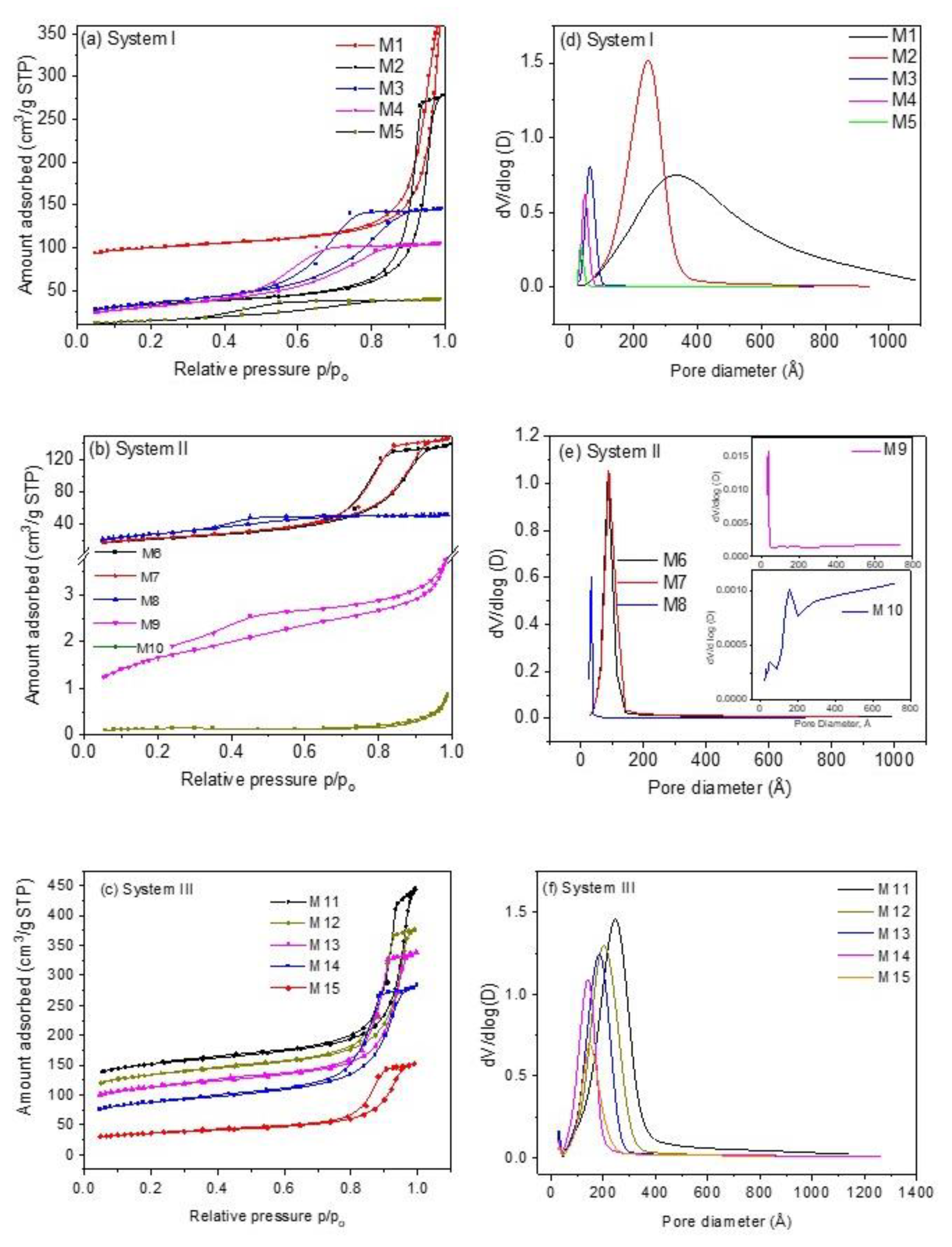
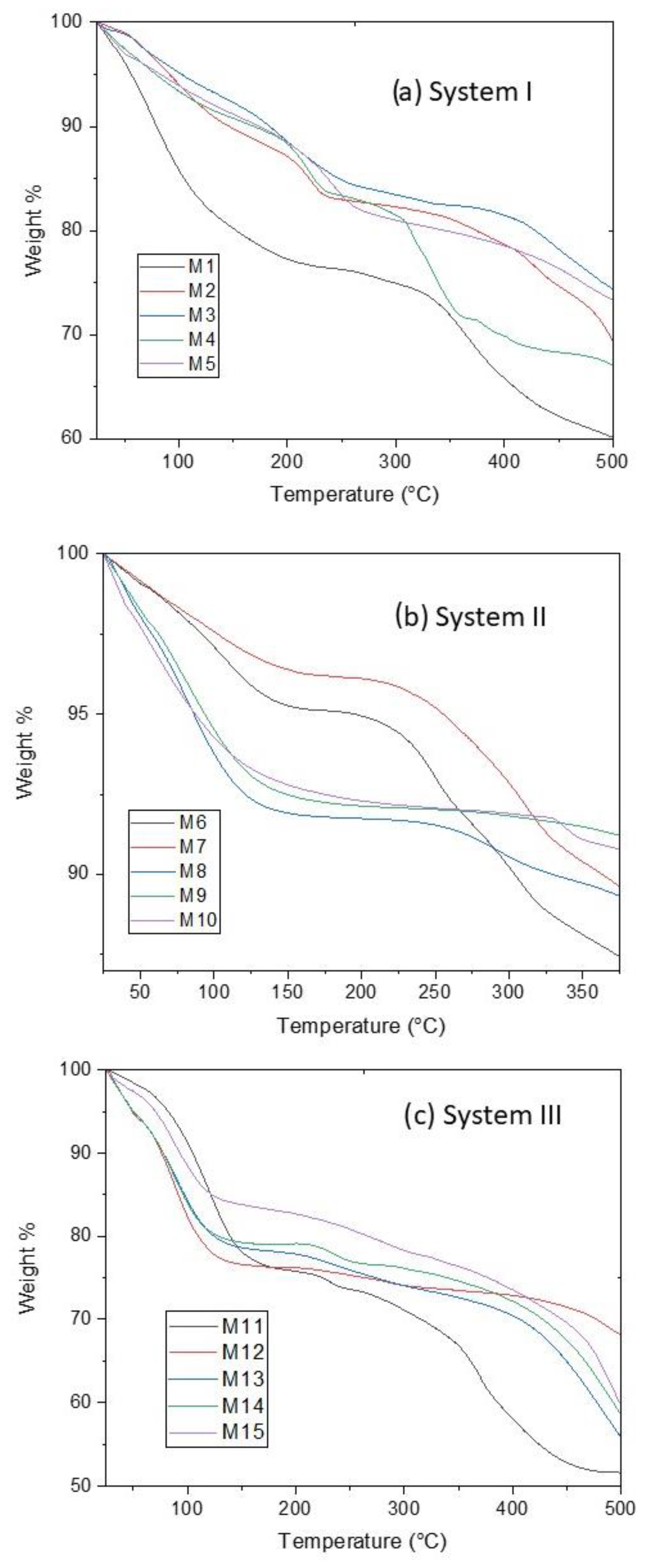



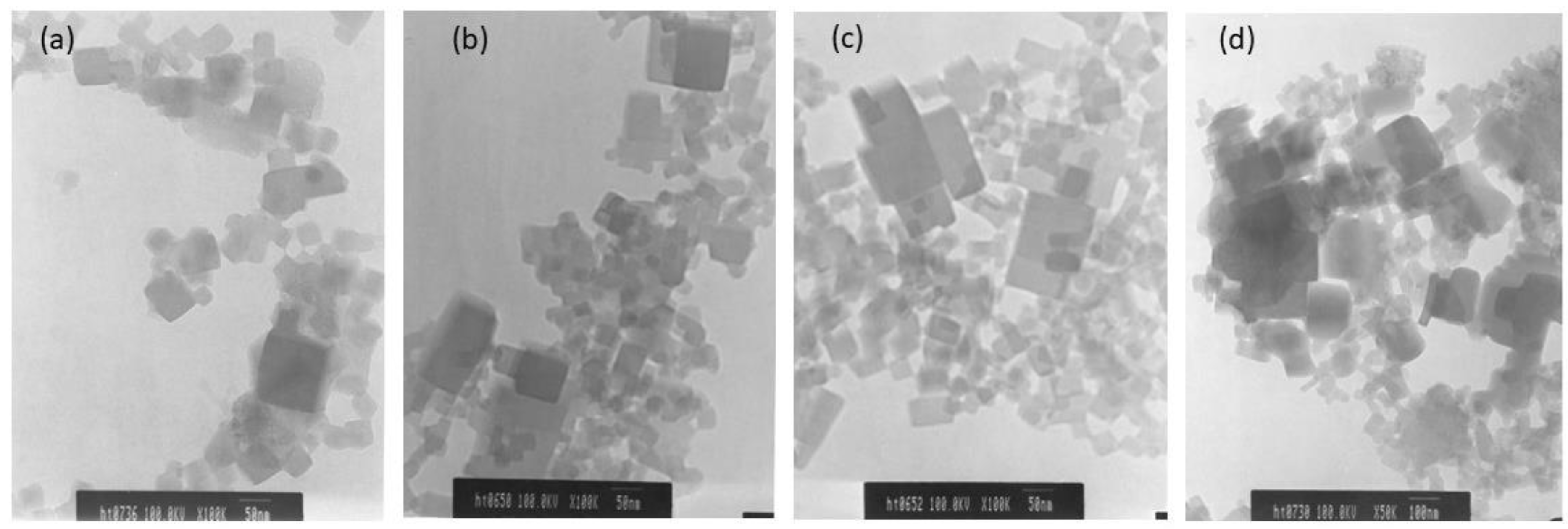
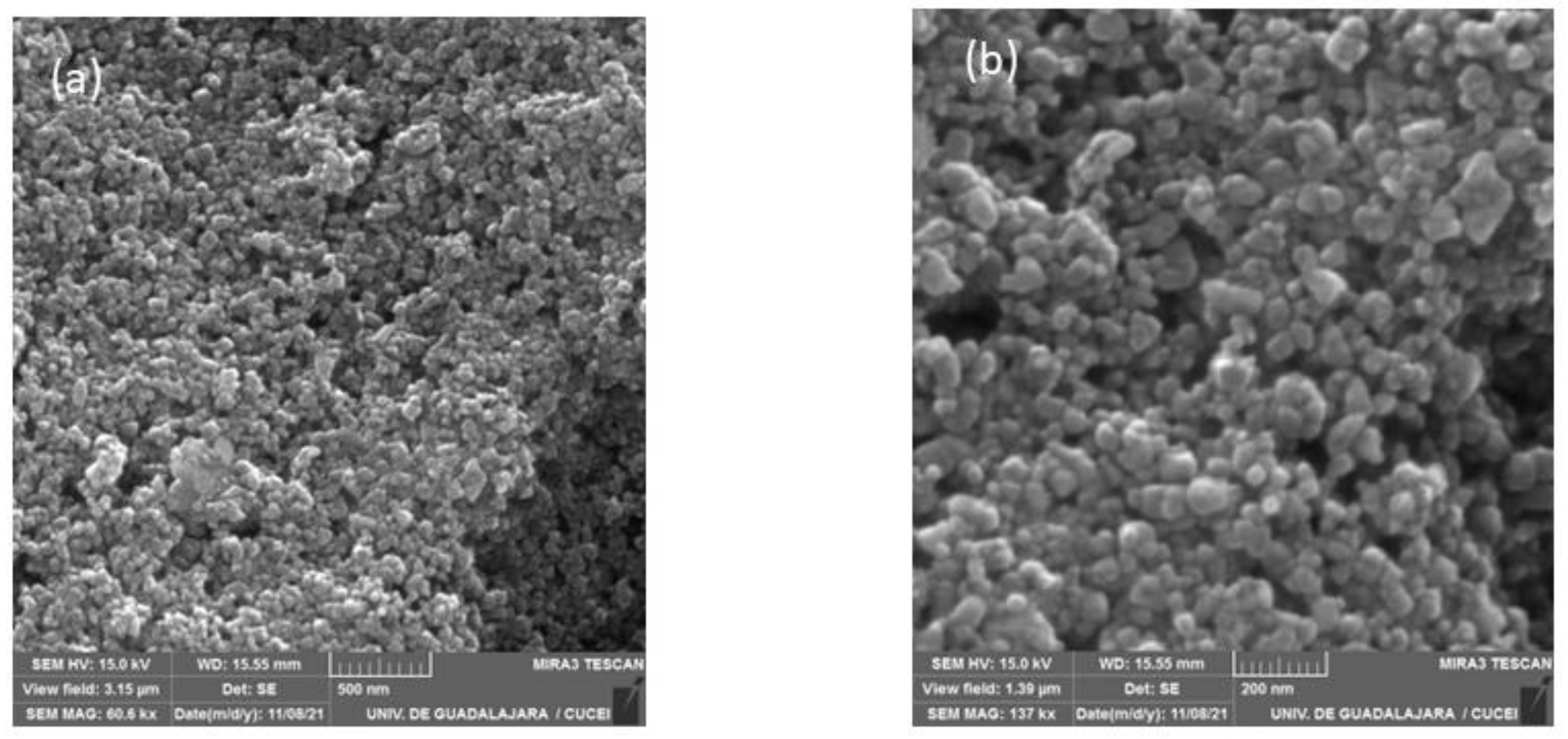


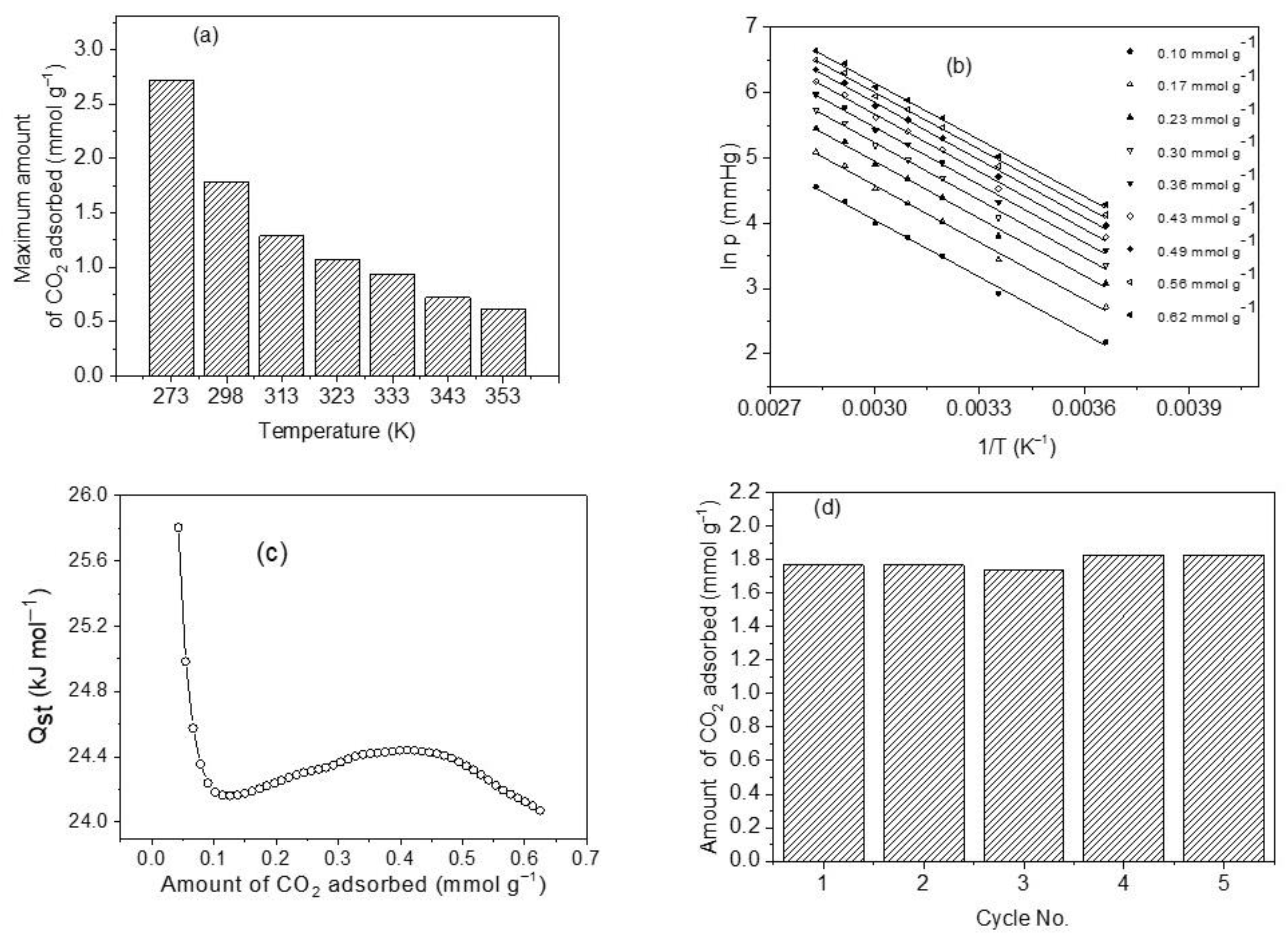
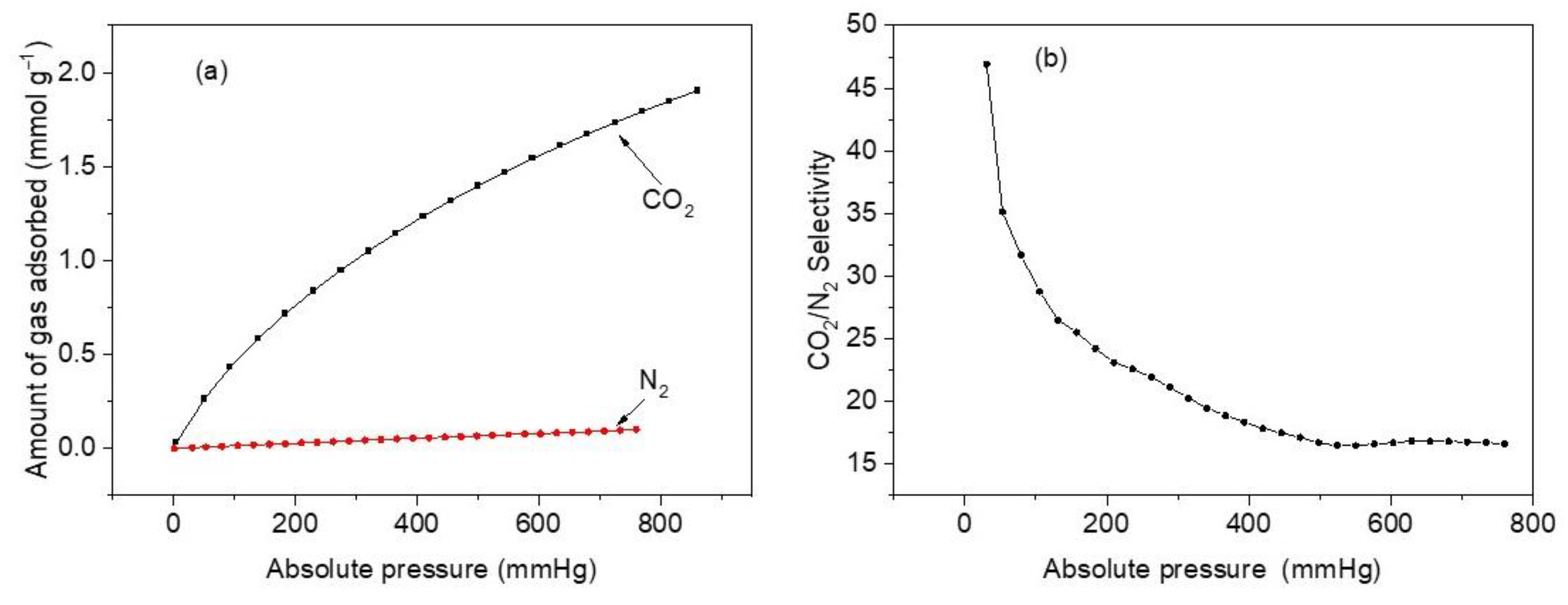
| Sample ID | Reactant Molar Ratio | SBET (m2 g−1) | Dp (Å) | Vt (cm3 g−1) | Sext (m2 g−1) | Smic (m2 g−1) | Vmic (cm3 g−1) | Vmeso (cm3 g−1) | Isotherm | Hysteresis | Formula |
|---|---|---|---|---|---|---|---|---|---|---|---|
| Na4Fe(CN)6: Co(NO3)2 | System I | ||||||||||
| M1 | 1.71:2.5 | 311.91 | 64.25 | 0.444 | 78.80 | 233.11 | 0.1205 | 0.3235 | IVa | H1 | |
| M2 | 1.71:2 | 110.83 | 155.23 | 0.417 | 73.06 | 37.77 | 0.0200 | 0.3970 | IVa | H1 | |
| M3 | 1.71:1.5 | 122.43 | 73.48 | 0.224 | 105.88 | 16.54 | 0.0084 | 0.2156 | IVa | H1 | |
| M4 | 1.71:1 | 109.53 | 59.12 | 0.162 | 97.99 | 11.54 | 0.0054 | 0.1566 | IVa | H1 | |
| M5 | 1.71:0.5 | 52.78 | 46.34 | 0.061 | 49.15 | 3.63 | 0.0014 | 0.0596 | IVa | H2b | |
| K4Fe(CN)6: Co(NO3)2 | System II | ||||||||||
| M6 | 1.71:2.5 | 77.63 | 109.09 | 0.216 | 68.13 | 9.50 | 0.0044 | 0.2116 | IVa | H1 | |
| M7 | 1.71:2 | 81.28 | 111.04 | 0.228 | 68.89 | 11.38 | 0.0053 | 0.2227 | IVa | H1 | |
| M8 | 1.71:1.5 | 101.41 | 31.67 | 0.085 | 91.65 | 9.74 | 0.0042 | 0.0808 | IVa | H1 | |
| M9 | 1.71:1 | 5.72 | 41.40 | 0.006 | 5.72 | ---- | 0.000074 | 0.0059 | II | H3 | |
| M10 | 1.71:0.5 | 0.45 | 106.69 | 0.001 | 0.4720 | ---- | 0.000012 | 0.0010 | II | H3 | |
| K3Fe(CN)6: Co(NO3)2 | System III | ||||||||||
| M11 | 1.71:2.5 | 479.21 | 55.56 | 0.505 | 170.91 | 308.30 | 0.1603 | 0.3447 | IVa | H1 | |
| M12 | 1.71:2 | 425.83 | 54.69 | 0.452 | 172.18 | 253.65 | 0.1320 | 0.3200 | IVa | H1 | |
| M13 | 1.71:1.5 | 362.87 | 57.74 | 0.399 | 159.68 | 203.18 | 0.1059 | 0.2931 | IVa | H1 | |
| M14 | 1.71:1 | 283.70 | 60.94 | 0.374 | 146.18 | 137.51 | 0.0720 | 0.3020 | IVa | H1 | |
| M15 | 1.71:0.5 | 117.99 | 79.73 | 0.215 | 72.69 | 45.29 | 0.0238 | 0.1912 | IVa | H1 | |
| Parameter | M1 | M6 | M11 |
|---|---|---|---|
| Space group | Fm-3m | P1 | Fm-3m |
| Crystal system | FCC | Triclinic | FCC |
| a (Å) | 10.220(9) | 10.056(2) | 10.267(1) |
| b (Å) | 10.220(9) | 10.078(2) | 10.267(1) |
| c (Å) | 10.220(9) | 10.070(3) | 10.267(1) |
| α (deg) | 90 | 89.96(9) | 90 |
| β (deg) | 90 | 88.47(2) | 90 |
| γ (deg) | 90 | 90.39(9) | 90 |
| Crystal size (Å) | 193.88 | 295.72 | 307.18 |
| Atoms per unit cell | Na8Co4Fe4C24N24 | K8Co4Fe4C24N24 | K4Co4Fe4C24N24 |
Disclaimer/Publisher’s Note: The statements, opinions and data contained in all publications are solely those of the individual author(s) and contributor(s) and not of MDPI and/or the editor(s). MDPI and/or the editor(s) disclaim responsibility for any injury to people or property resulting from any ideas, methods, instructions or products referred to in the content. |
© 2023 by the authors. Licensee MDPI, Basel, Switzerland. This article is an open access article distributed under the terms and conditions of the Creative Commons Attribution (CC BY) license (https://creativecommons.org/licenses/by/4.0/).
Share and Cite
Frías-Ureña, P.M.; Bárcena-Soto, M.; Orozco-Guareño, E.; Gutiérrez-Becerra, A.; Mota-Morales, J.D.; Chavez, K.; Soto, V.; Rivera-Mayorga, J.A.; Escalante-Vazquez, J.I.; Gómez-Salazar, S. Porous Structural Properties of K or Na-Co Hexacyanoferrates as Efficient Materials for CO2 Capture. Materials 2023, 16, 608. https://doi.org/10.3390/ma16020608
Frías-Ureña PM, Bárcena-Soto M, Orozco-Guareño E, Gutiérrez-Becerra A, Mota-Morales JD, Chavez K, Soto V, Rivera-Mayorga JA, Escalante-Vazquez JI, Gómez-Salazar S. Porous Structural Properties of K or Na-Co Hexacyanoferrates as Efficient Materials for CO2 Capture. Materials. 2023; 16(2):608. https://doi.org/10.3390/ma16020608
Chicago/Turabian StyleFrías-Ureña, Paloma M., Maximiliano Bárcena-Soto, Eulogio Orozco-Guareño, Alberto Gutiérrez-Becerra, Josué D. Mota-Morales, Karina Chavez, Víctor Soto, José A. Rivera-Mayorga, José I. Escalante-Vazquez, and Sergio Gómez-Salazar. 2023. "Porous Structural Properties of K or Na-Co Hexacyanoferrates as Efficient Materials for CO2 Capture" Materials 16, no. 2: 608. https://doi.org/10.3390/ma16020608
APA StyleFrías-Ureña, P. M., Bárcena-Soto, M., Orozco-Guareño, E., Gutiérrez-Becerra, A., Mota-Morales, J. D., Chavez, K., Soto, V., Rivera-Mayorga, J. A., Escalante-Vazquez, J. I., & Gómez-Salazar, S. (2023). Porous Structural Properties of K or Na-Co Hexacyanoferrates as Efficient Materials for CO2 Capture. Materials, 16(2), 608. https://doi.org/10.3390/ma16020608







